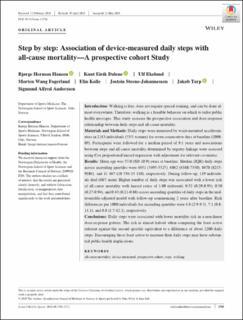| dc.contributor.author | Hansen, Bjørge Herman | |
| dc.contributor.author | Dalene, Knut Eirik | |
| dc.contributor.author | Ekelund, Ulf | |
| dc.contributor.author | Fagerland, Morten | |
| dc.contributor.author | Kolle, Elin | |
| dc.contributor.author | Steene-Johannessen, Jostein | |
| dc.contributor.author | Tarp, Jakob | |
| dc.contributor.author | Anderssen, Sigmund Alfred | |
| dc.date.accessioned | 2021-02-01T10:39:15Z | |
| dc.date.available | 2021-02-01T10:39:15Z | |
| dc.date.created | 2020-11-17T09:28:09Z | |
| dc.date.issued | 2020 | |
| dc.identifier.citation | Scandinavian Journal of Medicine & Science in Sports. 2020, 30(9), 1705-1711. | en_US |
| dc.identifier.issn | 0905-7188 | |
| dc.identifier.uri | https://hdl.handle.net/11250/2725528 | |
| dc.description | This is an open access article under the terms of the Creative Commons Attribution License, which permits use, distribution and reproduction in any medium, provided the original work is properly cited. | en_US |
| dc.description.abstract | Introduction: Walking is free, does not require special training, and can be done almost everywhere. Therefore, walking is a feasible behavior on which to tailor public health messages. This study assesses the prospective association and dose‐response relationship between daily steps and all‐cause mortality. Materials and Methods: Daily steps were measured by waist‐mounted accelerometers in 2183 individuals (53% women) for seven consecutive days at baseline (2008‐09). Participants were followed for a median period of 9.1 years and associations between steps and all‐cause mortality determined by registry linkage were assessed using Cox proportional hazard regression with adjustment for relevant covariates. Results: Mean age was 57.0 (SD 10.9) years at baseline. Median (IQR) daily steps across ascending quartiles were 4651 (3495‐5325), 6862 (6388‐7350), 8670 (8215‐9186), and 11 467 (10 556‐13 110), respectively. During follow‐up, 119 individuals died (68% men). Higher number of daily steps was associated with a lower risk of all‐cause mortality with hazard ratios of 1.00 (referent), 0.52 (0.29‐0.93), 0.50 (0.27‐0.94), and 0.43 (0.21‐0.88) across ascending quartiles of daily steps in the multivariable‐adjusted model with follow‐up commencing 2 years after baseline. Risk differences per 1000 individuals for ascending quartiles were 6.8 (2.9‐9.3), 7.1 (0.8‐11.1), and 8.0 (1.7‐12.1), respectively. Conclusions: Daily steps were associated with lower mortality risk in a non‐linear dose‐response pattern. The risk is almost halved when comparing the least active referent against the second quartile equivalent to a difference of about 2200 daily steps. Encouraging those least active to increase their daily steps may have substantial public health implications. | en_US |
| dc.language.iso | eng | en_US |
| dc.subject | all-cause mortality | en_US |
| dc.subject | device-measured | en_US |
| dc.subject | prospective cohort | en_US |
| dc.subject | steps | en_US |
| dc.subject | walking | en_US |
| dc.title | Step by step: Association of device‐measured daily steps with all‐cause mortality - A prospective cohort Study | en_US |
| dc.type | Peer reviewed | en_US |
| dc.type | Journal article | en_US |
| dc.description.version | publishedVersion | en_US |
| dc.rights.holder | © 2020 The Authors. | en_US |
| dc.source.pagenumber | 1705-1711 | en_US |
| dc.source.volume | 30 | en_US |
| dc.source.journal | Scandinavian Journal of Medicine & Science in Sports | en_US |
| dc.source.issue | 9 | en_US |
| dc.identifier.doi | 10.1111/sms.13726 | |
| dc.identifier.cristin | 1848636 | |
| dc.description.localcode | Institutt for idrettsmedisinske fag / Department of Sports Medicine | en_US |
| cristin.ispublished | true | |
| cristin.fulltext | original | |
| cristin.qualitycode | 2 | |
